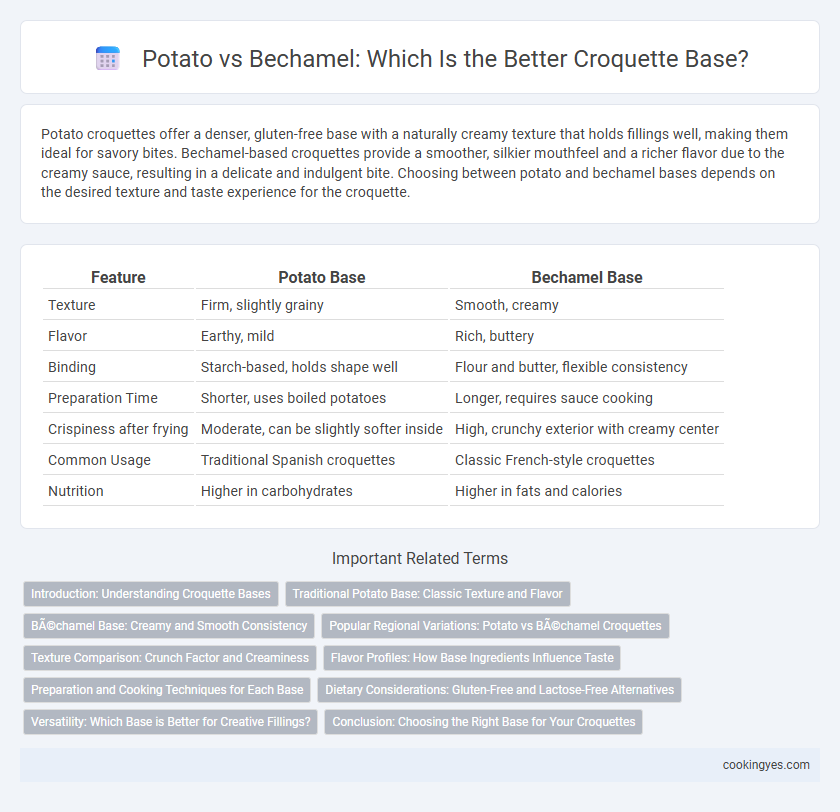Potato croquettes offer a denser, gluten-free base with a naturally creamy texture that holds fillings well, making them ideal for savory bites. Bechamel-based croquettes provide a smoother, silkier mouthfeel and a richer flavor due to the creamy sauce, resulting in a delicate and indulgent bite. Choosing between potato and bechamel bases depends on the desired texture and taste experience for the croquette.
Table of Comparison
| Feature | Potato Base | Bechamel Base |
|---|---|---|
| Texture | Firm, slightly grainy | Smooth, creamy |
| Flavor | Earthy, mild | Rich, buttery |
| Binding | Starch-based, holds shape well | Flour and butter, flexible consistency |
| Preparation Time | Shorter, uses boiled potatoes | Longer, requires sauce cooking |
| Crispiness after frying | Moderate, can be slightly softer inside | High, crunchy exterior with creamy center |
| Common Usage | Traditional Spanish croquettes | Classic French-style croquettes |
| Nutrition | Higher in carbohydrates | Higher in fats and calories |
Introduction: Understanding Croquette Bases
Croquettes typically use either potato or bechamel as their base, each offering distinct textures and flavors that define regional variations. Potato-based croquettes provide a firm, rustic bite and absorb spices well, making them popular in traditional European recipes. Bechamel bases create a creamy, smooth interior that contrasts with the crispy exterior, favored in French and Japanese styles for their delicate, melt-in-mouth quality.
Traditional Potato Base: Classic Texture and Flavor
Traditional croquettes rely on a potato base, offering a creamy, dense texture that holds fillings securely while delivering a comforting, earthy flavor. Potato-based croquettes maintain a natural starchiness that crisps beautifully when fried, creating a satisfying contrast between the golden crust and smooth interior. This classic preparation emphasizes simplicity and authenticity, highlighting the inherent qualities of potatoes to create a timeless dish.
Béchamel Base: Creamy and Smooth Consistency
A bechamel base for croquettes offers a creamy and smooth consistency that enhances the overall texture, providing a delicate mouthfeel compared to the denser potato base. The bechamel's rich, velvety sauce binds ingredients uniformly, allowing for a lighter and more refined croquette. This smooth base absorbs flavors effectively, making it ideal for incorporating cheeses, herbs, and finely minced proteins.
Popular Regional Variations: Potato vs Béchamel Croquettes
Potato croquettes dominate in regions like Spain and Latin America, prized for their creamy texture and ease of preparation using mashed potatoes combined with herbs and cured meats. Bechamel croquettes, prevalent in Catalonia and parts of France, rely on a rich, velvety white sauce base blended with ingredients like ham or cheese, offering a delicate, melt-in-the-mouth experience. These regional differences emphasize the versatility of croquettes, showcasing how foundational ingredients influence flavor profiles and cultural preferences across Mediterranean and European cuisines.
Texture Comparison: Crunch Factor and Creaminess
Potato-based croquettes offer a dense, creamy interior with a naturally smooth texture that contrasts sharply with their crispy, golden-brown crust, enhancing the crunch factor. Bechamel-based croquettes provide a luxuriously velvety and silky filling that melts in the mouth, while the exterior maintains a delicate crispness, delivering a balanced combination of creaminess and crunch. Texture-wise, potato croquettes emphasize hearty creaminess with robust crunch, whereas bechamel versions prioritize a refined, creamy softness paired with a tender crisp outer layer.
Flavor Profiles: How Base Ingredients Influence Taste
Potato-based croquettes offer a naturally earthy and creamy flavor with a slightly grainy texture that enhances the warmth of herbs and spices. Bechamel-based croquettes present a rich, smooth, and buttery taste, allowing for a more delicate and velvety mouthfeel that complements savory fillings like cheese and ham. The choice between potato and bechamel as a base significantly shapes the overall flavor profile, balancing heartiness versus creaminess in the final dish.
Preparation and Cooking Techniques for Each Base
Potato-based croquettes require boiling and mashing potatoes to a smooth consistency before mixing with seasonings and forming into shapes, followed by a thorough coating in breadcrumbs for a crispy exterior during deep-frying. Bechamel-based croquettes start with a roux of butter and flour, gradually whisked with milk to create a thick sauce that is cooled and combined with finely chopped ingredients, then shaped and breaded for frying. Each method demands precise temperature control--potato croquettes need evenly cooked, fluffy interiors, while bechamel croquettes require firm, creamy fillings that hold shape without being runny.
Dietary Considerations: Gluten-Free and Lactose-Free Alternatives
Potato-based croquettes naturally offer a gluten-free and lactose-free option, making them suitable for individuals with celiac disease or lactose intolerance. Bechamel-based croquettes typically contain gluten from flour and lactose from milk, requiring substitutions such as gluten-free flour and plant-based milk to accommodate dietary restrictions. Choosing potato as a base simplifies adherence to gluten-free and lactose-free diets without compromising traditional croquette texture and flavor.
Versatility: Which Base is Better for Creative Fillings?
Potato-based croquettes offer a dense and sturdy texture that holds up well to chunky or textured fillings like vegetables and minced meats, enhancing versatility in savory recipes. Bechamel-based croquettes provide a creamy, smooth interior that blends seamlessly with delicate or finely minced proteins, allowing for more refined and luscious filling combinations. Choosing the base depends on whether a firmer structure or a creamy consistency better complements the intended creative filling variations.
Conclusion: Choosing the Right Base for Your Croquettes
Potato-based croquettes offer a dense, hearty texture and subtle flavor that crisps well, making them ideal for rustic, comfort-style snacks. Bechamel-based croquettes provide a creamy, smooth interior with a delicate taste, perfect for refined, gourmet presentations. Selecting the right base depends on desired texture and flavor profile, with potatoes favored for robustness and bechamel for elegance and richness.
Potato vs Béchamel for croquette base Infographic

 cookingyes.com
cookingyes.com